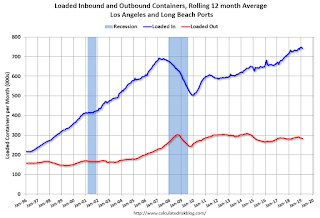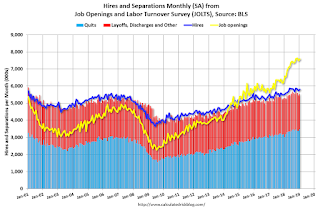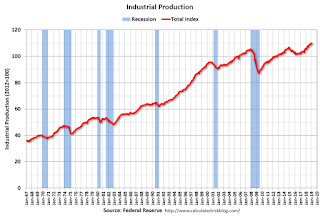by Calculated Risk on 3/17/2019 12:19:00 PM
Sunday, March 17, 2019
FOMC Preview
The consensus is that there will no change in policy at the FOMC meeting this week, and that the Fed will continue to emphasize "patience". Also the Fed is expected to announce the conclusion of the balance sheet runoff later this year (perhaps around September)
There might some slight downward revisions in the economic projections.
Here are the December FOMC projections.
The FOMC is projecting Q4 over the previous Q41, and 2018 came in at 3.1% real growth. (Note: Annual real GDP increased 2.9% in 2018)
Most analysts expect growth to slow in 2019, and Q1 forecasts are around 1% (many below 1%). So projections for 2019 might be revised down further.
| GDP projections of Federal Reserve Governors and Reserve Bank presidents | |||
|---|---|---|---|
| Change in Real GDP1 | 2018 | 2019 | 2020 |
| Dec 2018 | 3.0 to 3.1 | 2.3 to 2.5 | 1.8 to 2.0 |
| Sep 2018 | 3.0 to 3.2 | 2.4 to 2.7 | 1.8 to 2.1 |
The unemployment rate was at 3.8% in February. (The unemployment rate averaged 3.8% in Q4 2018). The unemployment rate projection for 2019 will probably be unchanged or revised up slightly.
| Unemployment projections of Federal Reserve Governors and Reserve Bank presidents | |||
|---|---|---|---|
| Unemployment Rate2 | 2018 | 2019 | 2020 |
| Dec 2018 | 3.7 | 3.5 to 3.7 | 3.5 to 3.8 |
| Sep 2018 | 3.7 | 3.4 to 3.6 | 3.4 to 3.8 |
As of December 2018, PCE inflation was up 1.7% from December 2017. This was below the projected range for 2018. However oil prices have stabilized (after falling sharply), and it seems likely any revision to 2019 projections will be minor.
| Inflation projections of Federal Reserve Governors and Reserve Bank presidents | |||
|---|---|---|---|
| PCE Inflation1 | 2018 | 2019 | 2020 |
| Dec 2018 | 1.8 to 1.9 | 1.8 to 2.1 | 2.0 to 2.1 |
| Sep 2018 | 2.0 to 2.1 | 2.0 to 2.1 | 2.1 to 2.2 |
PCE core inflation was up 1.9% in December year-over-year. Any change to Core PCE inflation for 2019 will probably be minor.
| Core Inflation projections of Federal Reserve Governors and Reserve Bank presidents | |||
|---|---|---|---|
| Core Inflation1 | 2018 | 2019 | 2020 |
| Dec 2018 | 1.8 to 1.9 | 2.0 to 2.1 | 2.0 to 2.1 |
| Sep 2018 | 1.9 to 2.0 | 2.0 to 2.1 | 2.1 to 2.2 |
In general the data has been somewhat softer than the FOMC's December projections.
Saturday, March 16, 2019
Schedule for Week of March 17, 2019
by Calculated Risk on 3/16/2019 08:12:00 AM
The key report this week is February existing home sales.
For manufacturing, the March Philly Fed manufacturing survey will be released.
The FOMC meets this week, and no change to policy is expected at this meeting.
10:00 AM: The March NAHB homebuilder survey. The consensus is for a reading of 63, up from 62. Any number above 50 indicates that more builders view sales conditions as good than poor.
No major economic releases scheduled. Note: Housing Starts for February will be released on March 26th.
7:00 AM ET: The Mortgage Bankers Association (MBA) will release the results for the mortgage purchase applications index.
During the day: The AIA's Architecture Billings Index for February (a leading indicator for commercial real estate).
2:00 PM: FOMC Meeting Announcement. No change to policy is expected at this meeting.
2:00 PM: FOMC Forecasts This will include the Federal Open Market Committee (FOMC) participants' projections of the appropriate target federal funds rate along with the quarterly economic projections.
2:30 PM: Fed Chair Jerome Powell holds a press briefing following the FOMC announcement.
8:30 AM: The initial weekly unemployment claims report will be released. The consensus is for 225 thousand initial claims, down from 229 thousand the previous week.
8:30 AM: the Philly Fed manufacturing survey for March. The consensus is for a reading of 4.4, up from -4.1.
 10:00 AM: Existing Home Sales for February from the National Association of Realtors (NAR). The consensus is for 5.08 million SAAR, up from 4.94 million.
10:00 AM: Existing Home Sales for February from the National Association of Realtors (NAR). The consensus is for 5.08 million SAAR, up from 4.94 million.The graph shows existing home sales from 1994 through the report last month.
10:00 AM: State Employment and Unemployment (Monthly) for February 2019
Friday, March 15, 2019
LA area Port Traffic Down Year-over-year in February
by Calculated Risk on 3/15/2019 05:55:00 PM
Container traffic gives us an idea about the volume of goods being exported and imported - and usually some hints about the trade report since LA area ports handle about 40% of the nation's container port traffic.
The following graphs are for inbound and outbound traffic at the ports of Los Angeles and Long Beach in TEUs (TEUs: 20-foot equivalent units or 20-foot-long cargo container).
To remove the strong seasonal component for inbound traffic, the first graph shows the rolling 12 month average.

On a rolling 12 month basis, inbound traffic was down 0.8% in February compared to the rolling 12 months ending in January. Outbound traffic was down 1.2% compared to the rolling 12 months ending the previous month.
The 2nd graph is the monthly data (with a strong seasonal pattern for imports).

In general imports have been increasing, and exports have mostly moved sideways over the last 8 years.
Q1 GDP Forecasts: Slightly Positive
by Calculated Risk on 3/15/2019 12:54:00 PM
From Goldman Sachs:
We lowered our Q1 GDP tracking estimate by two tenths to +0.4%. [March 15 estimate]From the NY Fed Nowcasting Report
emphasis added
The New York Fed Staff Nowcast stands at 1.4% for 2019:Q1 and 1.5% for 2019:Q2. [Mar 15 estimate].And from the Altanta Fed: GDPNow
The GDPNow model estimate for real GDP growth (seasonally adjusted annual rate) in the first quarter of 2019 is 0.4 percent on March 13, up from 0.2 percent on March 11. [Mar 13 estimate]CR Note: These early estimates suggest GDP will be slightly positive in Q1.
BLS: Job Openings Increased to 7.6 Million in January
by Calculated Risk on 3/15/2019 10:12:00 AM
Notes: In January there were 7.581 million job openings, and, according to the January Employment report, there were 6.535 million unemployed. So, for the eleventh consecutive month, there were more job openings than people unemployed. Also note that the number of job openings has exceeded the number of hires since January 2015 (4 years).
From the BLS: Job Openings and Labor Turnover Summary
The number of job openings was little changed at 7.6 million on the last business day of January, the U.S. Bureau of Labor Statistics reported today. Over the month, hires and separations were little changed at 5.8 million and 5.6 million, respectively. Within separations, the quits rate was unchanged at 2.3 percent and the layoffs and discharges rate was little changed at 1.1 percent. ...The following graph shows job openings (yellow line), hires (dark blue), Layoff, Discharges and other (red column), and Quits (light blue column) from the JOLTS.
The number of quits was little changed in January at 3.5 million. The quits rate was 2.3 percent. The quits level was little changed for total private but increased for government
emphasis added
This series started in December 2000.
Note: The difference between JOLTS hires and separations is similar to the CES (payroll survey) net jobs headline numbers. This report is for January, the most recent employment report was for February.
 Click on graph for larger image.
Click on graph for larger image.Note that hires (dark blue) and total separations (red and light blue columns stacked) are pretty close each month. This is a measure of labor market turnover. When the blue line is above the two stacked columns, the economy is adding net jobs - when it is below the columns, the economy is losing jobs.
Jobs openings increased in January to 7.581 million from 7.479 million in December.
The number of job openings (yellow) are up 15% year-over-year.
Quits are up 15% year-over-year. These are voluntary separations. (see light blue columns at bottom of graph for trend for "quits").
Job openings remain at a high level, and quits are still increasing year-over-year. This was a solid report.
Industrial Production Increased 0.1% in February
by Calculated Risk on 3/15/2019 09:21:00 AM
From the Fed: Industrial Production and Capacity Utilization
Industrial production edged up 0.1 percent in February after decreasing 0.4 percent in January. Manufacturing production fell 0.4 percent in February for its second consecutive monthly decline. The index for utilities rose 3.7 percent, while the index for mining moved up 0.3 percent. At 109.7 percent of its 2012 average, total industrial production was 3.5 percent higher in February than it was a year earlier. Capacity utilization for the industrial sector edged down 0.1 percentage point in February to 78.2 percent, a rate that is 1.6 percentage points below its long-run (1972–2018) average.
emphasis added
 Click on graph for larger image.
Click on graph for larger image.This graph shows Capacity Utilization. This series is up 11.5 percentage points from the record low set in June 2009 (the series starts in 1967).
Capacity utilization at 78.2% is 1.6% below the average from 1972 to 2017 and below the pre-recession level of 80.8% in December 2007.
Note: y-axis doesn't start at zero to better show the change.
 The second graph shows industrial production since 1967.
The second graph shows industrial production since 1967.Industrial production increased in February to 109.7. This is 26% above the recession low, and 4.1% above the pre-recession peak.
The increase in industrial production and decrease in capacity utilization were below consensus.
NY Fed: Manufacturing "Business activity grew only slightly in New York State"
by Calculated Risk on 3/15/2019 08:45:00 AM
From the NY Fed: Empire State Manufacturing Survey
Manufacturing firms in New York State reported that business activity expanded only slightly. The general business conditions index fell five points to 3.7, its third consecutive monthly reading below 10, suggesting that growth has remained quite a bit slower so far this year than it was for most of 2018.This was below the consensus forecast.
The index for number of employees climbed ten points to 13.8, pointing to an increase in employment levels, though the average workweek index turned negative for the first time since 2016. emphasis added
Thursday, March 14, 2019
Friday: Industrial Production, Job Openings, NY Fed Mfg Survey
by Calculated Risk on 3/14/2019 06:27:00 PM
Friday:
• At 8:30 AM ET, The New York Fed Empire State manufacturing survey for March. The consensus is for a reading of 10.0, up from 8.8.
• At 9:15 AM, The Fed will release Industrial Production and Capacity Utilization for February. The consensus is for a 0.4% increase in Industrial Production, and for Capacity Utilization to increase to 78.5%.
• At 10:00 AM, University of Michigan's Consumer sentiment index (Preliminary for March).
• At 10:00 AM, Job Openings and Labor Turnover Survey for January from the BLS.
A few Comments on January New Home Sales
by Calculated Risk on 3/14/2019 03:34:00 PM
First, this report was for January; the February report will be released on March 29th.
New home sales for January were reported at 607,000 on a seasonally adjusted annual rate basis (SAAR). This was below the consensus forecast, however the three previous months were revised up.
With these revisions, sales increased 2.3% in 2018 compared to 2017. I expect sales to be around the same level in 2019 as in 2018 (not fall off a cliff), and my guess is we haven't seen the peak of this cycle yet.
On Inventory: Months of inventory is now above the top of the normal range, however the number of units completed and under construction is still somewhat low. Inventory will be something to watch very closely.
Earlier: New Home Sales decreased to 607,000 Annual Rate in January.

This graph shows new home sales for 2018 and 2019 by month (Seasonally Adjusted Annual Rate).
The comparison will be most difficult in Q1.
And here is another update to the "distressing gap" graph that I first started posting a number of years ago to show the emerging gap caused by distressed sales. Now I'm looking for the gap to close over the next several years.
 The "distressing gap" graph shows existing home sales (left axis) and new home sales (right axis) through January 2019. This graph starts in 1994, but the relationship had been fairly steady back to the '60s.
The "distressing gap" graph shows existing home sales (left axis) and new home sales (right axis) through January 2019. This graph starts in 1994, but the relationship had been fairly steady back to the '60s. Following the housing bubble and bust, the "distressing gap" appeared mostly because of distressed sales. The gap has persisted even though distressed sales are down significantly, since new home builders have focused on more expensive homes.
I still expect this gap to slowly close. However, this assumes that the builders will offer some smaller, less expensive homes. If not, then the gap will persist.
However, this assumes that the builders will offer some smaller, less expensive homes. If not, then the gap will persist.
xisting home sales are counted when transactions are closed, and new home sales are counted when contracts are signed. So the timing of sales is different.
New Home Sales decreased to 607,000 Annual Rate in January
by Calculated Risk on 3/14/2019 11:19:00 AM
Note: This release is for January (this was delayed due to the government shutdown). The February report is scheduled for March 29th.
The Census Bureau reports New Home Sales in January were at a seasonally adjusted annual rate (SAAR) of 607 thousand.
The previous three months were revised up significantly.
"Sales of new single‐family houses in January 2019 were at a seasonally adjusted annual rate of 607,000, according to estimates released jointly today by the U.S. Census Bureau and the Department of Housing and Urban Development. This is 6.9 percent below the revised December rate of 652,000 and is 4.1 percent below the January 2018 estimate of 633,000."
emphasis added
 Click on graph for larger image.
Click on graph for larger image.The first graph shows New Home Sales vs. recessions since 1963. The dashed line is the current sales rate.
Even with the increase in sales over the last several years, new home sales are still somewhat low historically.
The second graph shows New Home Months of Supply.
 The months of supply increased in January to 6.6 months from 6.3 months in December.
The months of supply increased in January to 6.6 months from 6.3 months in December. The all time record was 12.1 months of supply in January 2009.
This is above the normal range (less than 6 months supply is normal).
"The seasonally‐adjusted estimate of new houses for sale at the end of January was 336,000. This represents a supply of 6.6 months at the current sales rate."
 On inventory, according to the Census Bureau:
On inventory, according to the Census Bureau: "A house is considered for sale when a permit to build has been issued in permit-issuing places or work has begun on the footings or foundation in nonpermit areas and a sales contract has not been signed nor a deposit accepted."Starting in 1973 the Census Bureau broke this down into three categories: Not Started, Under Construction, and Completed.
The third graph shows the three categories of inventory starting in 1973.
The inventory of completed homes for sale is still somewhat low, and the combined total of completed and under construction is a little low.
 The last graph shows sales NSA (monthly sales, not seasonally adjusted annual rate).
The last graph shows sales NSA (monthly sales, not seasonally adjusted annual rate).In January 2019 (red column), 45 thousand new homes were sold (NSA). Last year, 48 thousand homes were sold in January.
The all time high for January was 92 thousand in 2005, and the all time low for January was 21 thousand in 2011.
This was below expectations of 620,000 sales SAAR, however the three previous months were revised up significantly. I'll have more later today.


